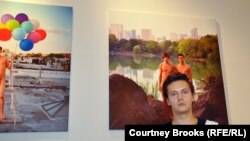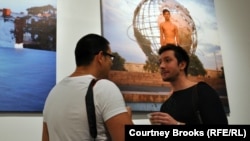NEW YORK -- Alexander Kargaltsev was bullied so severely in university for being gay that he transferred schools.
He was beaten with batons and tased by police during a small gay-pride gathering in Moscow. Later, he and a friend were detained by police as they left a gay club.
But despite all the trauma the 27-year-old Russian refugee has been through, he refuses to be silenced.
In 2011, Kargaltsev was granted asylum in the United States. On October 26 in New York City, he held his first American solo exhibition -- simply entitled "Asylum" -- in downtown Manhattan.
More than a dozen large prints adorned the small studio. Each portrayed a nude gay or bisexual Russian man, with New York City shown in the background.
Each man wore a stern expression, and many were photographed provocatively in public areas, such as Central Park.
Under each photo is a caption: "Granted Asylum" or "Asylum Pending."
'What Russia Loses'
Kargaltsev told RFE/RL that it was a "political" series, designed to fight for gay rights in Russia.
He said it also shows what Russia throws away by persecuting its gay and bisexual citizens.
"I was trying to choose young guys, healthy, well-educated, even handsome guys, to show what Russia loses," Kargaltsev said. "And I wanted to show New York. So they are here, they could be back there, they could have been happy, and so on."
The curator of the gallery, Ivan Savvine, is also a gay refugee from Russia. The gallery, 287 Spring, was only opened last month.
Savvine said the images portray both vulnerability and strength, and are a visual representation of the courage required to come out as a gay man, both in the East and the West.
"This nakedness -- that's the word I like to use in this regard, not even nudity but nakedness because it's very intentional, and that's what a refugee experience is," Savvine said. "It's starting your life from scratch somewhere where you may not even know the language, may not have any connections, family, or friends. You are all by yourself in a foreign culture without necessary education, without job skills, without any money, without anyone to support you. And still, you have to make your way somehow through this life."
Pushed Out?
Kargaltsev, who was a film and theater director and photographer in his native Moscow, originally came to New York City on a full scholarship to the New York Film Academy. He applied for asylum after his arrival.
This year has seen ramped-up discrimination against homosexuals and bisexuals in Russia. A law passed in St. Petersburg in February criminalizes "gay propaganda."
American pop icon Madonna is being sued for $10 million under that legislation after passing out pink armbands and asking Russians to show respect and love for gays and lesbians during an August concert in the city.
In June, a Moscow ban on gay-pride parades for the next 100 years was passed.
A sign in place of one of the photos reads: "This work has been removed from the exhibition at the request of Mr. Kargaltsev's models who posed for this portrait. They are afraid that the publicity that this project has received may lead to the persecution of their family members in Russia by government officials."
Kargaltsev's exhibition was packed on opening night, with international asylum seekers and Americans intrigued by the work, and continued through October 28.
Two of the attendees were a gay couple, legally married in the United States, still seeking a green card for the Venezuelan partner who has been living in the United States for 21 years. The couple, who were in their 50s, told RFE/RL that while the Russians in the portraits were very young, "we are all still fighting the same fight."
One of the models, Dmitry, is a 27-year-old musician from Moscow. He sought asylum in the United States in 2011 and his application is still pending.
"I feel safe here," he said, "And I found my love."
He was beaten with batons and tased by police during a small gay-pride gathering in Moscow. Later, he and a friend were detained by police as they left a gay club.
But despite all the trauma the 27-year-old Russian refugee has been through, he refuses to be silenced.
In 2011, Kargaltsev was granted asylum in the United States. On October 26 in New York City, he held his first American solo exhibition -- simply entitled "Asylum" -- in downtown Manhattan.
More than a dozen large prints adorned the small studio. Each portrayed a nude gay or bisexual Russian man, with New York City shown in the background.
Each man wore a stern expression, and many were photographed provocatively in public areas, such as Central Park.
Under each photo is a caption: "Granted Asylum" or "Asylum Pending."
'What Russia Loses'
Kargaltsev told RFE/RL that it was a "political" series, designed to fight for gay rights in Russia.
He said it also shows what Russia throws away by persecuting its gay and bisexual citizens.
"I was trying to choose young guys, healthy, well-educated, even handsome guys, to show what Russia loses," Kargaltsev said. "And I wanted to show New York. So they are here, they could be back there, they could have been happy, and so on."
The curator of the gallery, Ivan Savvine, is also a gay refugee from Russia. The gallery, 287 Spring, was only opened last month.
Savvine said the images portray both vulnerability and strength, and are a visual representation of the courage required to come out as a gay man, both in the East and the West.
"This nakedness -- that's the word I like to use in this regard, not even nudity but nakedness because it's very intentional, and that's what a refugee experience is," Savvine said. "It's starting your life from scratch somewhere where you may not even know the language, may not have any connections, family, or friends. You are all by yourself in a foreign culture without necessary education, without job skills, without any money, without anyone to support you. And still, you have to make your way somehow through this life."
Pushed Out?
Kargaltsev, who was a film and theater director and photographer in his native Moscow, originally came to New York City on a full scholarship to the New York Film Academy. He applied for asylum after his arrival.
This year has seen ramped-up discrimination against homosexuals and bisexuals in Russia. A law passed in St. Petersburg in February criminalizes "gay propaganda."
American pop icon Madonna is being sued for $10 million under that legislation after passing out pink armbands and asking Russians to show respect and love for gays and lesbians during an August concert in the city.
In June, a Moscow ban on gay-pride parades for the next 100 years was passed.
A sign in place of one of the photos reads: "This work has been removed from the exhibition at the request of Mr. Kargaltsev's models who posed for this portrait. They are afraid that the publicity that this project has received may lead to the persecution of their family members in Russia by government officials."
Kargaltsev's exhibition was packed on opening night, with international asylum seekers and Americans intrigued by the work, and continued through October 28.
Two of the attendees were a gay couple, legally married in the United States, still seeking a green card for the Venezuelan partner who has been living in the United States for 21 years. The couple, who were in their 50s, told RFE/RL that while the Russians in the portraits were very young, "we are all still fighting the same fight."
One of the models, Dmitry, is a 27-year-old musician from Moscow. He sought asylum in the United States in 2011 and his application is still pending.
"I feel safe here," he said, "And I found my love."














